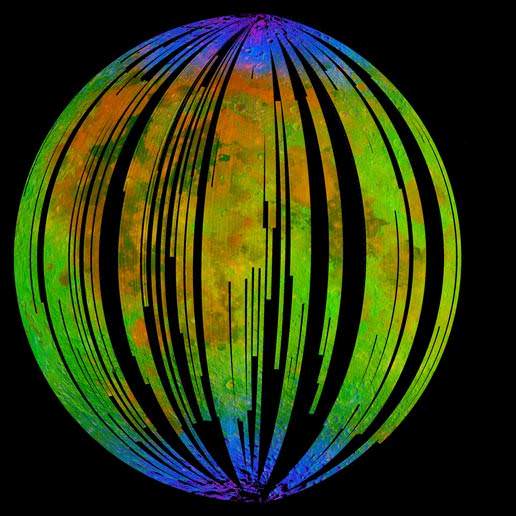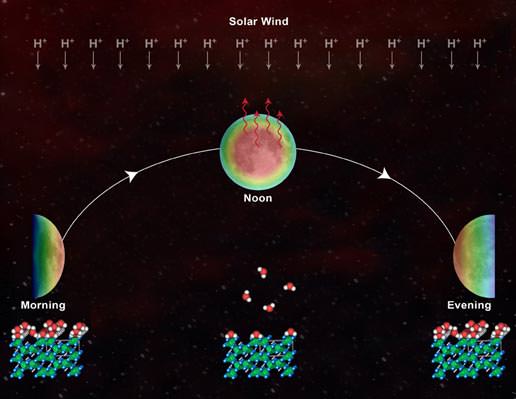[/caption]
“Water cycle on the Moon” is a phrase that many people – including lunar scientists – were never expecting to hear. This surprising new finding of ubiquitous water on the surface of the Moon, revealed and confirmed by three different spacecraft last year, has been one of the main topics of recent discussion and study by lunar researchers. But figuring out the cycle of how water appears and disappears over the lunar day remains elusive. As of now, scientists suspect a few different processes that could be delivering water and hydroxyl (OH) to the lunar surface: meteorites or comets hitting the Moon, outgassing from the Moon’s interior, or the solar wind interacting with the lunar regolith. But so far, none of the details of any of these processes are adding up.
Dana Hurley from The Johns Hopkins University Applied Physics Laboratory is part of team of scientists attempting to model the lunar water cycle, and she discussed the work at the NASA Lunar Science Institute’s third annual Lunar Forum at Ames Research Center, July 20-22, 2010.
“When we do the model, we assume the way that the water is lost is through photodissociation, and so that sets the timescale,” Hurley told Universe Today. “And using that timescale the amount that is coming in through the solar wind or micrometeorites can’t add up to the amount observed if it is in steady state, so something is not jiving.”
Photodissociation involves the breaking up of a substance into simpler components by the radiant energy of sunlight.
It appears the amount of water varies over the course of the lunar day. Two observations a week apart by a spectrometer on the repurposed Deep Impact spacecraft (now called EPOXI) showed the region that was near the Moon’s terminator at dawn had a detectable amount of water and hydroxyl, and a week later when it was near noon, those substances were gone. But the new region at dawn then had H2O and OH.
One theory holds that the water and hydroxyl are, in part, formed from hydrogen ions in the solar wind. By local noon, when the moon is at its warmest, some water and hydroxyl are lost. By evening, the surface cools again, and the water and hydroxyl return.
But, Hurley said, the solar wind in steady state does not reproduce the observed surface density of water and hydroxyl.
Additionally, looking at the other possible sources — the known source rate of micrometeoroids and comets — doesn’t provide the amount of observed H20 and OH either.
“We’d really like to have a lot more observations to understand how it evolves over the course of the day,” Hurley said.

In her talk, Hurley said her team has been trying to look at all possible angles and ideas, including recent larger comet hits on the Moon, or potentially a seasonal event where water deposited at winter poles could be released when it warms up in summer. But so far none of these ideas have been tested or modeled, and as of now do not provide a solution to the daily cycle of water that was observed.
She also noted that since there are obviously some unique processes going on, the interaction between the surface and atmosphere needs more study.
“The surface and atmosphere are coupled,” Hurley said in an interview with Universe Today. “The atmosphere is produced from the surface; there is no atmosphere that lasts for a long time on the Moon and it is constantly being produced and lost. And so it is coming from the surface, either from something that is coming from the lunar regolith grains or something that is interacting with those grains, whether it is solar wind or something that is impacting. So, the surface is the source of the atmosphere and that atmosphere comes back and interacts with the surface again. And you really have to understand that whole system.”
So, what is her best guess as to the source of the water?
Hurley said there has to be some sort of recycling going on within the regolith, and perhaps a complex surface chemistry that allows the H20 and OH to exist for longer periods of time, which would better explain the surface density.
“What I’ve looked at is what could be happening in the atmosphere and how things hop around from the surface up and then back down to the surface,” she said. “The lunar regolith is rather loose, and these small particles and gases can go down within the regolith and be within the top several centimeters and work their way down and back out. So there is an exchange going on in that top layer that is kind of acting as a reservoir. That is my best guess of what is going on.”


So it’s likely all these sources and a complex reservoir.
Of course that reservoir could itself be a source (hydrated minerals, refreshed by impacts) and a mediator of [dun, dun] *The Deep Waters of the Moon*. [/dun, dun] Oh, and I’ll argue that is horse’s hoof beats, not zebra’s – the reservoir is neither pristine dry nor isolated.
How active still is its core anyway?
How about the cosmic rays ?
Oh, it likely has a core, see here, here, here and here. (And the paper that we got in astrobiology class: “Thermal core-mantle coupling in an early lunar dynamo: Implications for a global magnetic field and magnetosphere of the early Moon”, Takahashi & Tsunakawa, Geophys Res, 2009.)
It is controversial of course. Even more controversial is the possibility it is still molten (which I was unaware of), see the last link.
This makes Wikipedia correct. And apparently “the Moon’s time-variable rotation indicate that the core is at least partly molten” with yet another ref.
@Torbjorn Larsson OM
My understanding is that the moon does not have much, if any, core.
@Sweeneytodd
How would cosmic rays be a source of water?
@ Michael Poston.
My fault, i dind’t express my self well.
I was thinking that maybe cosmic rays could be involved in reactions with the regolith.. or other chemicals under the surface..
what i wanted to say was that i wanted to know if cosmic rays were involeved or not..
But i don’t have much knowledge about the geology and of the moon or the nature of cosmic rays to determine it on my one.
:p
If mine is a stupid question, i’m sorry 😀 i don’t meen it
Tons of Lunar information is located at the Lunar and Planetary Institute website.
http://www.lpi.usra.edu/lunar/
@Sweeneytodd
I looked a little bit into cosmic rays, and since they are about 89% protons, it is conceivable that they could be involved in water formation. They are orders of magnitude higher in energy than the solar wind, so it would likely be a very different process, and a much more difficult one for us to repeat in the lab.
I forgot: the T&T model is used to explain the magnetometer and mineral finds. It looks good actually, and shows that while Earths first mantle plumes made it and put plate tectonics in motion, the Moon’s major plume didn’t make it. It made an interesting early and vagrant field, but small enough not to affect Earth too much to mess up models of _our_ the field & ionosphere.
Odds are we will find Mars in between vs plate tectonics; after all, the Moon core is disproportional small due to its history as impactor ejecta. Venus is a bit of a mystery, though.
Isn’t it possible some water may be migrating to moon from earth?
@torbjorn larsson om
My bad, my information about the core was from before the rather convincing magnetic studies released in 2009. So the moon has a core, it was active 3-4 billion years ago, but it is only about 1-3% of the moon’s mass.
What I’m now wondering is: does the fact that the moon can polarize in response to earth’s magnetic field mean that there is still some molten iron in the core? And if so, given the measurement yielded 1-3%, does that mean that 1-3% is still liquid and the actual solid core could be much bigger? This would support the solid core with molten outer layer model.
However, we seem to have gotten off topic. How is the activity of the core related to the observed water cycle?
A very interesting finding.. which might lead to?
The Moon is outside of the Earth’s magnetic field for most of the month (~2/3 of its orbit) and passes through a portion of the magneto-tail during the New Moon phase (1/3), at which point, it is also experiences the coldest (no illumination) temperatures. ‘Cold flow’ plasma condensates anyone?
Question: What is the elemental composition of the Earth’s magneto-tail? Are ‘sputtered’ oxygen atoms from Earth’s atmosphere more predominant in the magneto-tail?
Oops…. “IN the Earth’s magneto-tail”, not “..of..”
@elilio
the thought is that any water outside the earth’s magnetic field would be dissociated by solar radiation or cosmic rays very quickly, much more quickly than it could get to the moon.
however…
it is interesting to think about what happens while the moon dips inside the earth’s magneto tail… could the earth be delivering oxygen or even water to the moon? who knows? let’s send a probe to find out!
@aqua
isn’t the time that the moon is in the earth’s magneto-tail the Full Moon phase?
as far as I can collect from the article, it seems the scientists are worried about where the water on the surface of the moon comes from. My query is where did the water on poles come from?
@Scrambler Sinister
The water at the poles could have come from comets impacting the moon (the same place it is believed the earth got its water from) or by “cold trapping” migrating water (perhaps created by the solar wind?) wandering around on the lunar surface. Once it gets to the permanent shadow regions, is has a very low probability of leaving again.